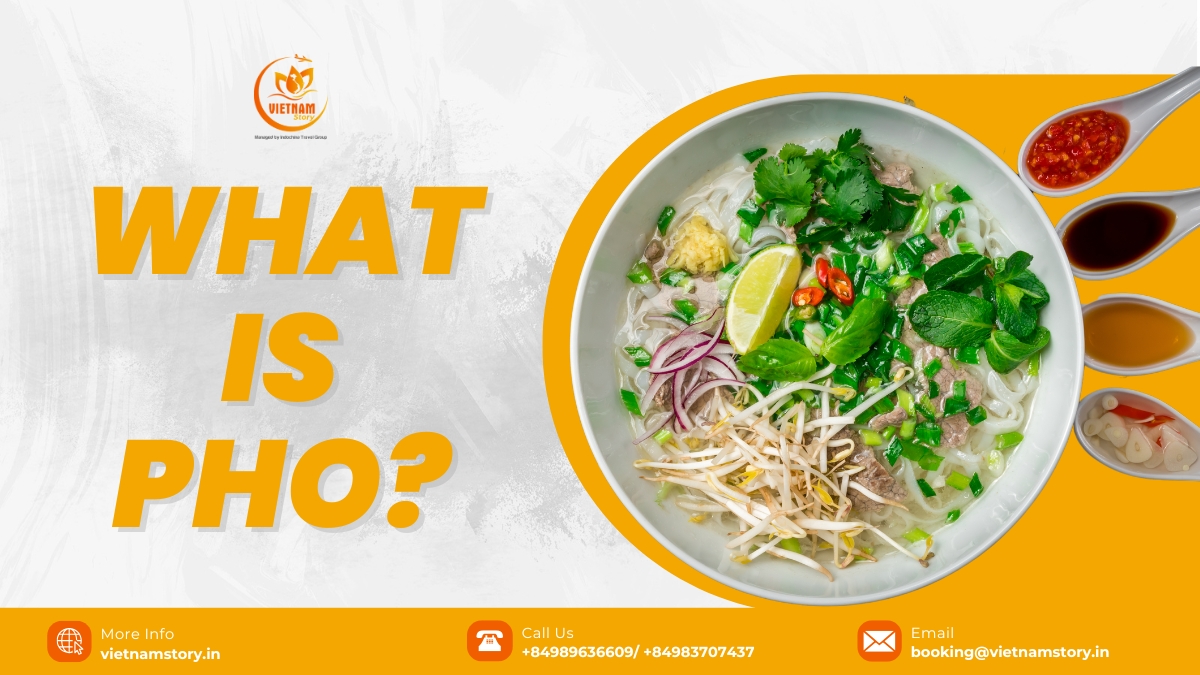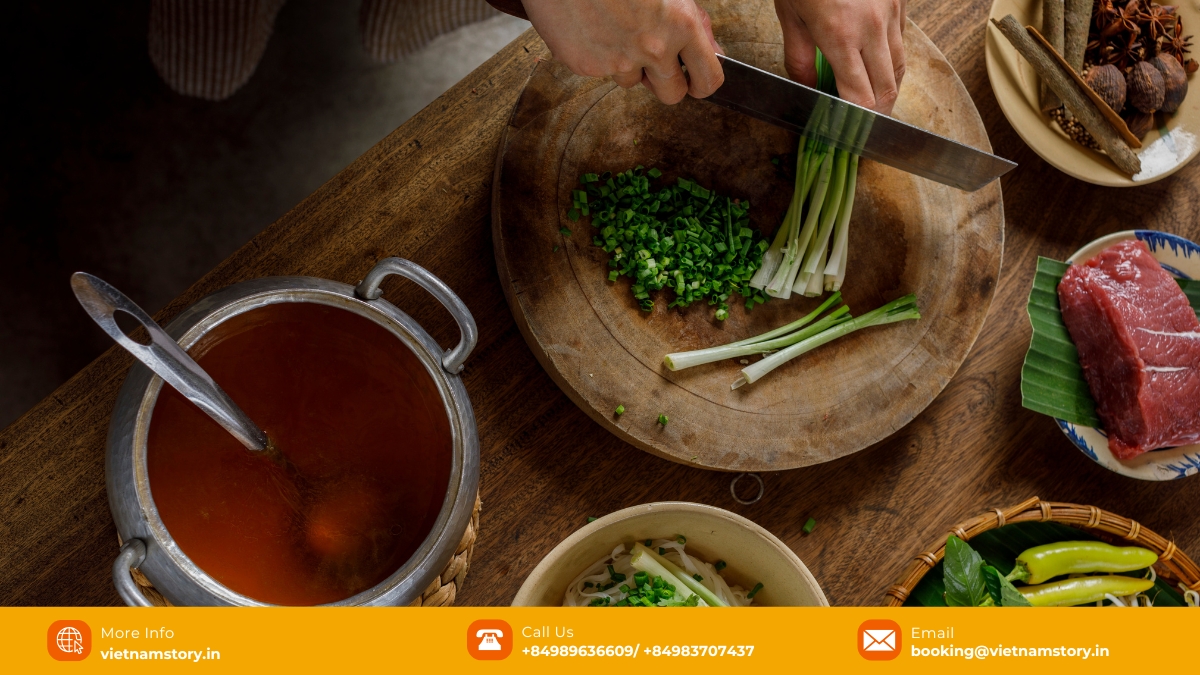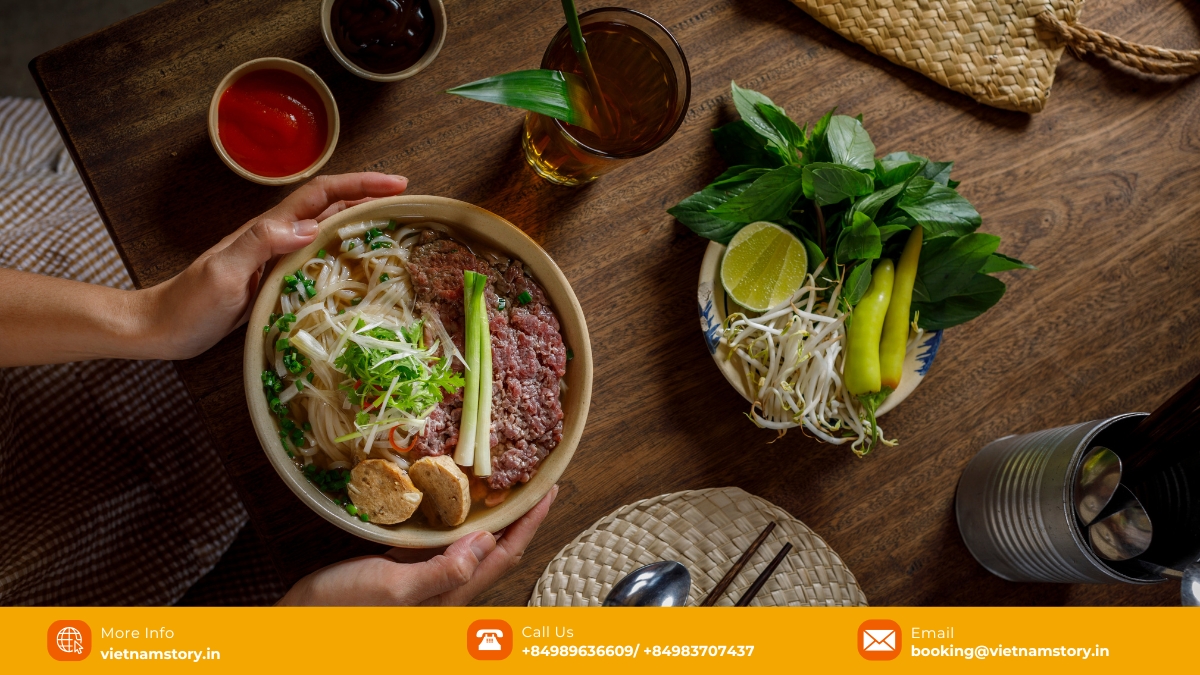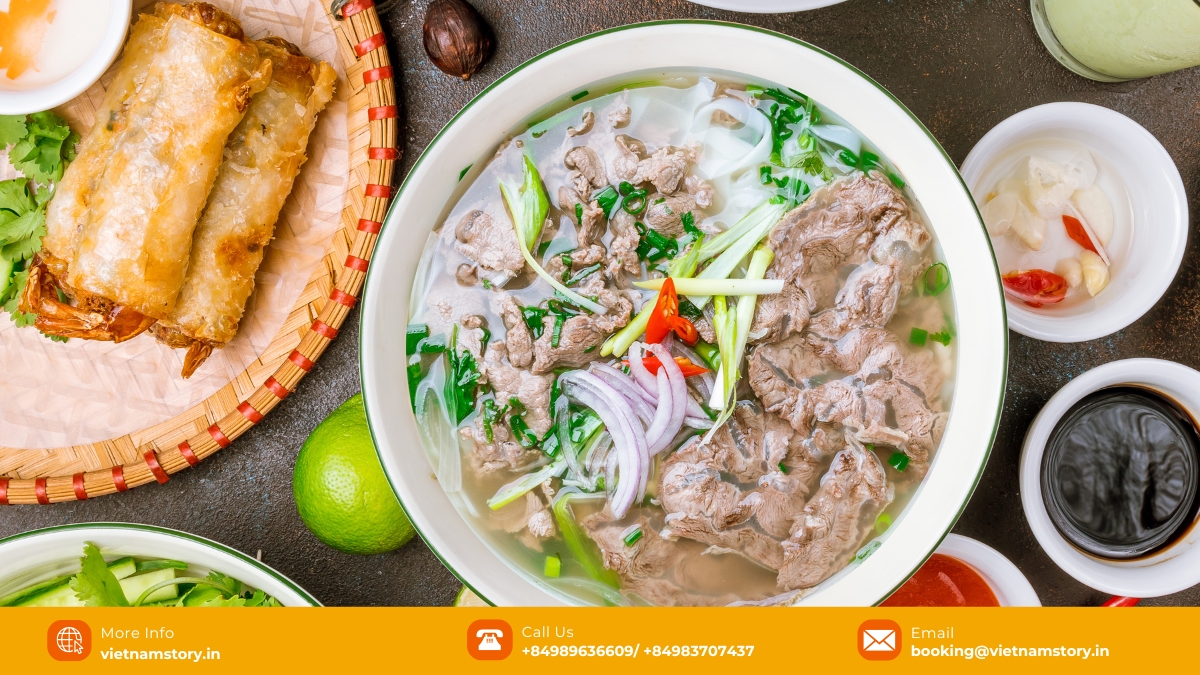
What Is Pho? The Essence of Vietnam in a Bowl
At its core, Pho is a Vietnamese soup consisting of aromatic bone broth, rice noodles (`bánh phở`), and thinly sliced meat (most commonly beef). It’s a dish that beautifully balances simplicity with complexity, relying on the quality of its fundamental components.
While often associated with beef (`phở bò`), Pho can also be prepared with chicken (`phở gà`), and increasingly, with other proteins like pork, fish, or tofu for vegetarian options (`phở chay`).
Considered the national dish of Vietnam, Pho holds a special place in the hearts of Vietnamese people, evoking feelings of comfort, nostalgia, and home. It’s a dish that transcends social classes, enjoyed equally in bustling street stalls and elegant restaurants across the country.
The Culinary Genesis: Origins and Evolution of Pho
The precise origins of Pho remain somewhat shrouded in the mists of time, but most accounts trace its emergence to early 20th-century northern Vietnam, likely in Hanoi. While the exact influences are debated, it’s generally accepted that Pho’s creation was a unique synthesis of Vietnamese culinary traditions with influences from French and Chinese cuisine.
The French occupation of Vietnam introduced new ingredients and culinary techniques. The French love of beef, particularly, is often cited as a factor in the development of Pho’s signature beef broth. The word “pho” itself is widely believed to originate from the French word “feu,” meaning “fire,” linking it potentially to the French beef stew pot-au-feu. Alternatively, some experts suggest the name evolved from the Vietnamese pronunciation of the Chinese word “fen,” meaning “flat rice noodle,” highlighting the Chinese influence on the noodle component.
After the division of Vietnam in 1954, many northerners migrated south, bringing Pho with them. In the south, particularly in Saigon (now Ho Chi Minh City), the dish began to evolve, incorporating new ingredients and styles influenced by local produce and resident Chinese and Cambodian populations. This migration and adaptation led to the distinct regional variations we see today.

What is Pho’s Key Components?
Pho, at its core, consists of a few fundamental components: the broth, the noodles, the meat or protein, and the toppings. The interplay between these elements creates the dish’s characteristic flavor and texture.
The Broth: The Heart and Soul
The broth, the heart and soul of any good Pho, is a testament to Vietnamese culinary mastery. The traditional broth is created by slow-simmering beef bones (often shank and knee bones) for many hours, typically six to ten hours, and in some authentic recipes, up to 24 hours, along with spices and aromatics. These crucial aromatics include star anise, cloves, cinnamon, ginger, onion, and sometimes cardamom or coriander. Fish sauce is also a key seasoning ingredient.
This long simmering process draws out the deep flavors of the bones and spices, creating a complex, savory, and fragrant base. While beef broth (`phở bò`) is most traditional, variations exist with chicken (`phở gà`), and vegetarian versions (`phở chay`), employing vegetable broths and tofu or mushrooms as protein sources. Regardless of the base, the broth must be clear and aromatic, reflecting the time and care taken in its preparation.
The Noodles: The Perfect Vessel
The flat rice noodles, known as `bánh phở`, are a crucial component, forming the foundation for the Pho experience. These noodles, made from rice flour, possess a slightly chewy texture that is both delicate and satisfying. They are specifically designed to absorb the broth’s flavor while maintaining their structure. The width and thickness of the `bánh phở` can vary slightly depending on the region.
The Protein: More Than Just Beef
The type of meat or protein used in Pho is a key determinant of its flavor and style. In beef Pho (`phở bò`), common cuts include thinly sliced beef sirloin (often added raw to cook in the hot broth), brisket, and flank steak. More adventurous eaters might also find cuts like tendon, tripe, or bone marrow. Chicken Pho (`phở gà`) uses various parts of the chicken, sometimes even including less common parts like gizzards or immature chicken eggs in traditional preparations. Vegetarian versions (`phở chay`) often include tofu, mushrooms, or mock meats.
The Toppings: A Symphony of Fresh Flavors
Toppings provide a vital layer of texture, flavor, and customization to a bowl of Pho. The most common and essential toppings include fresh bean sprouts, fresh herbs like Thai basil, cilantro, mint, and sawtooth coriander (`ngo gai`), lime wedges for acidity, and thinly sliced white and green onions. These fresh elements are crucial, offering a contrast to the warm broth and rich meat.
Optional toppings, allowing for individual customization, include chili peppers or chili oil, hoisin sauce, and chile-garlic sauce (like Sriracha®). A small dish of these sauces mixed with lime juice is a popular dipping option.
A Tale of Two Bowls: Northern and Southern Pho

While Pho is enjoyed nationwide, distinct regional variations have developed over time, particularly between the northern and southern styles. These differences, shaped by history, local ingredients, and culinary preferences, offer unique experiences:
Northern Pho (`Phở Bắc`)
Considered closer to the original, Northern Pho is known for:
- The Broth: Often characterized by a lighter, clearer, and more subtly flavored broth. The emphasis is on the purity of the broth, using fewer spices and focusing on the natural flavor of the beef bones and a bit of salt. It’s described as more delicate and refined.
- The Noodles: The `bánh phở` noodles used are generally wider and flatter.
- The Meat: Typically simpler cuts of beef, such as thinly sliced brisket or flank. Less emphasis on a wide variety of meat textures.
- The Toppings: Generally more restrained, usually limited to thinly sliced green onions, sometimes a touch of cilantro or basil. The focus is on the broth and meat flavors. Hoisin and Sriracha are often served on the side, not added directly to the bowl. In Hanoi, the birthplace of Northern Pho, you can also find other unique specialties like the famous Vietnam Egg Coffee.
Southern Pho (“Phở Nam”)
Southern Pho developed later and is influenced by the region’s climate and diverse populations:
- The Broth: Known for its richer, sweeter, and more complex broth. It uses a wider range of spices (including rock sugar for sweetness) and fish sauce, resulting in a bolder flavor profile.
- The Noodles: The `bánh phở` noodles are generally thinner and a bit softer.
- The Meat: Offers a wider variety of meat options, commonly including brisket, flank, tendon, tripe, and beef balls. The emphasis is on diverse textures.
- The Toppings: Renowned for its abundance of fresh herbs and toppings, including ample bean sprouts, Thai basil, mint, cilantro, lime, and sometimes jalapenos or chili peppers. Hoisin and Sriracha are commonly added directly to the bowl by the diner.
A Matter of Taste: Neither Superior Nor Inferior
It’s important to note that neither Northern nor Southern Pho is inherently superior or inferior. They are simply different expressions of the same beloved dish, each shaped by its regional traditions and culinary preferences. Exploring both styles is an essential part of any culinary journey through Vietnam.

Experiencing Pho: The Art of Enjoying Your Bowl
Enjoying Pho is not merely about consuming a meal; it’s about engaging in a ritual, a journey of customization. You’ll typically be provided with a bowl of hot soup containing noodles, meat, and broth, alongside a separate plate of fresh garnishes. Use chopsticks to handle the noodles and meat, and a deep soup spoon to enjoy the broth. A common technique is to twirl some noodles onto the spoon with some broth and a slice of meat for a perfect bite.
Personalize your bowl by adding the fresh herbs, bean sprouts, and a squeeze of lime to the broth. Then, experiment with hoisin sauce, Sriracha, or chili oil to adjust the flavor to your liking. Don’t be shy about mixing sauces or creating a dipping sauce on the side. And yes, slurping your noodles is perfectly acceptable!
Pho is a deeply ingrained part of Vietnamese daily life, enjoyed for breakfast, lunch, or dinner. Sharing a bowl with friends or family fosters a sense of community and is a highlight for many visitors experiencing Vietnam’s vibrant street food scene. On your culinary journey, don’t forget to explore other iconic Vietnamese beverages, like learning how to drink Vietnamese coffee in a local cafe.
READ MORE: A Culinary Tapestry: Embracing The Flavors Of Vietnam
Is Pho Healthy? Is Pho Gluten-Free?
Within Vietnamese culture, Pho is widely regarded as a restorative and nutritious dish. The long-simmered bone broth is seen as nourishing, and the fresh herbs add vitamins and flavor without heavy fats. Many Vietnamese turn to Pho as a comforting remedy when feeling under the weather.
Generally, Pho is considered a gluten-free food. The traditional `bánh phở` noodles are made from 100% rice flour. As long as the broth is made without gluten-containing ingredients (which is typical for authentic recipes) and the toppings or sauces added are also gluten-free, Pho is a safe and delicious option for those with gluten sensitivities.
How to Pronounce Pho
Here’s a quick tip to help you sound like a local when ordering: While it looks like “foe,” Pho is pronounced “fuh,” rhyming with “duh.” Knowing the correct pronunciation will certainly enhance your experience!
Why Try Pho During Your Vietnam Trip?
For Indian tourists exploring Vietnam, trying an authentic bowl of Pho is an absolutely essential part of the journey. It’s more than just food; it’s a direct connection to the country’s culture, history, and daily life. Experiencing the complex flavors of a slow-simmered broth, customizing your bowl with vibrant herbs, and soaking in the atmosphere of a local Pho shop offers a unique and memorable sensory experience that truly captures the essence of Vietnam. While savoring this iconic soup, be open to exploring the vast culinary landscape Vietnam offers, from daily street food delights to understanding the cultural significance behind festive foods like what is Mooncake.
Conclusion
Pho is more than just a noodle soup; it’s a sensory experience, a cultural ambassador, and a powerful symbol of Vietnamese identity. It’s a testament to the country’s culinary creativity, its commitment to fresh ingredients, and its ability to blend tradition with innovation. Whether you’re savoring the subtle elegance of Northern Pho in Hanoi or the bold flavors of its Southern counterpart in Ho Chi Minh City, you’re embarking on a journey that transcends the mere act of eating.
Embrace the aromas, textures, and the countless variations of Pho, and you will discover why this dish has captured the hearts (and stomachs) of people around the globe. Pho, in its diverse and delicious forms, invites you to experience the soul of Vietnam, one steaming bowl at a time. Make sure it’s at the top of your culinary list during your visit!












